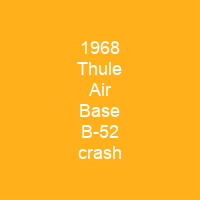On 21 January 1968, a United States Air Force B-52 bomber crashed near Thule Air Base in the Danish territory of Greenland. The aircraft was carrying four B28FI thermonuclear bombs on a Cold War alert mission when a cabin fire forced the crew to abandon the aircraft before they could carry out an emergency landing. Six crew members ejected safely, but one who did not have an ejection seat was killed while trying to bail out. The bomber crashed onto sea ice in North Star Bay, Greenland, causing the conventional explosives aboard to detonate and the nuclear payload to rupture and disperse.
About 1968 Thule Air Base B-52 crash in brief

In 1966, U.S. Secretary of Defense Robert McNamara proposed cutting \”Chrome Dome\” flights because the BMEWS system was fully operational, the bombers had been made redundant by missiles, and USD 123 million could be saved. SAC and the Joint Chiefs of Staff opposed the plan, so a compromise was reached whereby a smaller force of four bombers would be on alert each day. Despite the reduced program and the risks highlighted by the 1966 Palomares B- 52 crash, SAC continued to dedicate one of its aircraft to monitoring Thule air base. Beginning in 1961, B-51 bombers also secretly flew as part of the \”Hard Head\” mission over Thule. The objective of the mission is to keep a close eye on the base and its missile early warning system, which is located at 75°0′N 67°30′W 75. 000°N 67. 500°W) 75. 000; -67. 500; -65.000; The bomber crew consisted of five regular crew members, including Captain John Haug, the aircraft commander. Also aboard were a substitute navigator ) and a mandatory third pilot. Shortly after take-off, another cushion was placed under the navigator’s seat in the aft section of the lower deck. The flight was unfulfilled until the scheduled mid-air refueling was conducted manually from a KC-135 Stratotanker, which had to be conducted manually because of an error with the engine bleed valve. About one hour after the refueling, Captain Haug directed his co-pilot Svitenko to take his rest period, while the aircraft was circling its designated area.
You want to know more about 1968 Thule Air Base B-52 crash?
This page is based on the article 1968 Thule Air Base B-52 crash published in Wikipedia (as of Dec. 08, 2020) and was automatically summarized using artificial intelligence.







